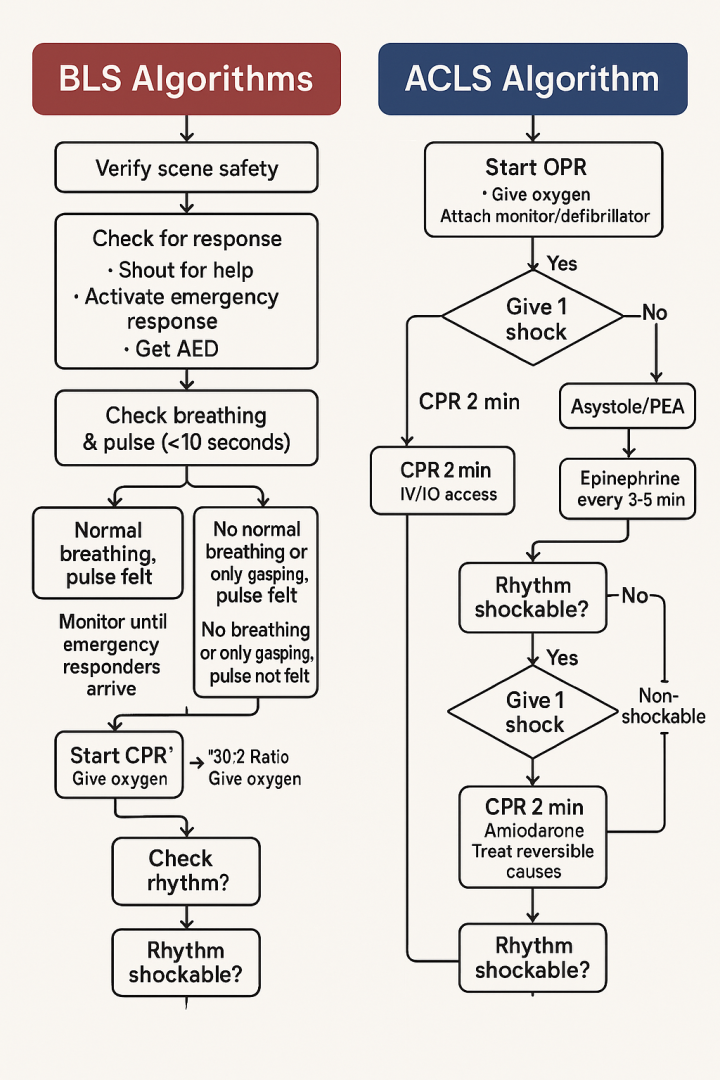If you’re a student preparing for your BLS or ACLS certification, the algorithms can seem like a lot to memorize. But with a simple breakdown, they become powerful tools that guide you through life-saving decisions.
This guide simplifies the core BLS and ACLS algorithms so you can learn them faster and apply them with confidence.
Part 1: BLS Algorithm (Adult)
Step-by-Step Summary:
- Check Responsiveness
- Tap and shout: “Are you okay?”
- Call for help and activate EMS
- Assess Breathing and Pulse (5–10 seconds)
- No breathing or only gasping?
- No pulse within 10 seconds?
- Start CPR
- 30 compressions : 2 breaths (if trained)
- Push hard and fast (100–120/min)
- Depth: At least 2 inches
- Use an AED ASAP
- Follow prompts
- Shockable rhythm? Deliver a shock and resume CPR immediately
- Continue CPR
- 2-minute cycles with pulse/rhythm checks
Key Tips:
- Switch rescuers every 2 minutes to avoid fatigue
- Minimize interruptions during compressions
Part 2: ACLS Adult Cardiac Arrest Algorithm
1. Start CPR & Give Oxygen
- Attach defibrillator/monitor
2. Check Rhythm
- Shockable? (VF/pulseless VT)
- Deliver shock
- Resume CPR immediately (2 minutes)
- Administer epinephrine every 3–5 minutes
- Consider antiarrhythmics (amiodarone/lidocaine)
- Non-shockable? (Asystole/PEA)
- Resume CPR immediately (2 minutes)
- Administer epinephrine every 3–5 minutes
- Identify and treat reversible causes (H’s & T’s)
3. Return of Spontaneous Circulation (ROSC)
- Optimize ventilation and oxygenation
- Monitor BP, consider advanced airway
- Get 12-lead ECG
Part 3: Bradycardia with a Pulse (Symptomatic)
- Assess and Maintain Airway
- Oxygen if needed & Monitor ECG/BP/O2
- IV Access
- Evaluate symptoms
- Hypotension?
- Altered mental status?
- Chest pain?
- If Yes:
- Atropine first (0.5 mg IV every 3–5 min, max 3 mg)
- Consider pacing, dopamine, or epinephrine infusion if ineffective
Part 4: Tachycardia with a Pulse (Symptomatic)
- Assess and Monitor
- Stable vs Unstable?
- Unstable? Synchronized cardioversion
- Stable?
- Wide QRS? Consider antiarrhythmic (amiodarone)
- Narrow QRS? Try vagal maneuvers, adenosine
Part 5: Post-Cardiac Arrest Care
- Maintain SpO₂ > 94%
- Avoid hyperventilation
- Consider therapeutic hypothermia if unresponsive
- Hemodynamic and neurologic support
- Advanced critical care planning
The H’s and T’s (Reversible Causes)
H’s:
- Hypovolemia
- Hypoxia
- Hydrogen ion (acidosis)
- Hypo-/Hyperkalemia
- Hypothermia
T’s:
- Tension pneumothorax
- Tamponade (cardiac)
- Toxins
- Thrombosis (pulmonary or coronary)
- Trauma
Final Study Tips:
- Use flowcharts and flashcards
- Watch ACLS megacode videos
- Practice mock scenarios
- Study in short, focused sessions
Remember: Algorithms aren’t about memorization—they’re about knowing what to do next when every second counts. Practice builds confidence!


